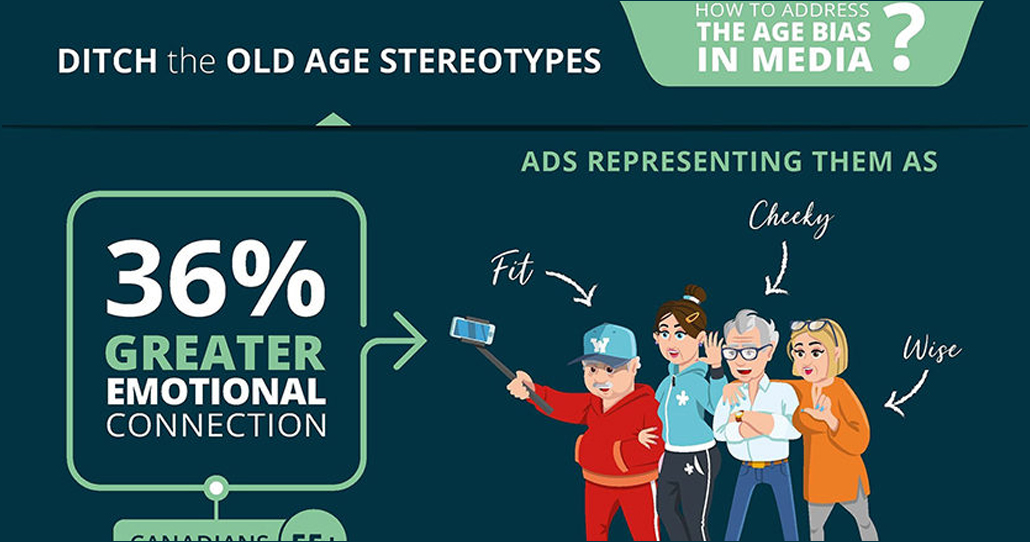Move over Mansplaining, there’s a new trend afoot. Youngsplaining (or what academics tend to refer to as ageism) is becoming rampant, and you just may be engaging in it without even being aware of it.
To see if you’re guilty of this, ask yourself this: when you think of the 55+ demographic which of the following words come to mind: senior, frail, fumbling, elderly, retired or confused? If you selected any of these words, then you are guilty of Youngsplaining, and your preconceptions of the 55+ consumer are way off the mark.
The reality is that today’s 55+ Canadian is anything but all of those “labels” mentioned above. More importantly, using ageist biases when marketing to your 55+ clients risks completely alienating them. With 11 million Canadians falling into the fastest growing consumer segment (1), not knowing how to talk to the 55+ set could mean leaving a lot of lost revenue on the table. A prior article focused on what not to do when talking to your 55+ clients. In addition, the insights below will help you get to know this demographic a little better:
You’ll find the 55+ Canadian active on everything from Instagram to Facebook
While the introduction of digital media may have been perplexing at first leading to many ageist-based jokes, today this group is very digital savvy. You’ll find them reading books on tablets, logging “likes” on Facebook, surfing the Internet on their smartphones, and binge-watching series on laptops. They have Google homes, use Siri and are using technology more than ever before. In fact, Canadians 65+are the fastest growing group of Internet users; 70% of them are online every day, with Facebook being their platform of choice(2). HomeEquity Bank has profiles on Facebook, Twitter, LinkedIn, YouTube and Instagram, so you may want to consider sharing or leveraging this purpose-built content (especially Facebook!) to reach your 55+ customer. Speak to your Business Development Manager on how to get started.
As every successful relationship proves, don’t ignore the woman
While financial and retirement planning does tend to cater to the couple, if you are talking mainly to the husband, you are missing the mark. Women in this demographic have been contributing financially to the household over the years, earning them an equal say in financial decisions. There’s more to consider: these women are typically living longer than their counterparts. So in the future you may not be marketing to a couple at all; instead, you may be marketing to widows and single women. All this to say that including women in financial discussion at the very onset is key.
Remember how children should be seen and not heard? Now forget it
The 55+ consumer places a high importance on teaching their children and leaving a positive legacy for future generations. So tap into how important it is for them to serve as positive role models for their children by being financially independent at this stage in life. Touch on how wonderful it is to be able to help out future generations financially with things like tuition or a down payment for a home. Don’t ignore the children: include them in your conversations and if necessary, in your meetings. Remember, adult children also may be advising their parents behind the scenes. And it may not be in your favour.
Don’t know what an 8 track or Howdy Doody are? You should
In times of uncertainty, it is human nature to want to latch onto the familiar. The 55+ Canadian is no exception. As this group tries to navigate the new uncertain reality ahead, they take comfort in memories of a time when they felt more in control. Consider using visual or auditory cues that tap into nostalgia that was relevant when this group was growing up with. Need a bit of help? Huffington Post lists 50 things that this generation would highly relate to.
Ask yourself why you aren’t asking questions
To tailor your sell message, you need to know who you are talking to and what matters to them. Not everyone will divulge that information without prompting. So ask the questions. Find out what’s on their bucket list, what are their fears, who is helping influence their decision-making, and anything else that will help you market to them more effectively.
Don’t label, enable
The moral here is clear: Youngsplaining risks alienating your 55+ clients. It sends the message that you don’t know them at all, and alienating this group could mean leaving a lot of lost revenue on the table. So get to know your 55+ client and see them as they see themselves.
HomeEquity Bank worked in partnership with neuroscience research firm Brainsights to take a deeper dive into the 55+ Canadian. To access the valuable findings of the study, click here.
Click here to download the complete Brainsights study!
Sources:
1Statistics Canada
1IPSOS Research
2Government of Canada, Insights West, Media in Canada








